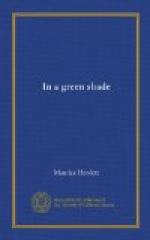But those who intended to settle there had to devise a better way of reaching it than that of aiming at somewhere else and being caught in a storm. What should you do when you had no compass? One way, perhaps as good as any, was Floki Wilgerdsson’s. “He made ready a great sacrifice and hallowed three ravens who were to tell him the way.” It was a near thing though. The first raven flew back into the bows; the second went up into the air, but then came aboard again. “The third flew forth from the bows to the quarter where they found the land.” It was then very cold. They saw a frith full of sea-ice—enough for Floki. He called the country Iceland, and the name has stuck. They stayed out the spring and summer, then sailed back to Norway, of divided minds concerning the adventure. “Floki spoke evil of the country; but Herolf told the best and the worst of it; and Thorolf said that butter dripped out of every blade of grass there.” He was a poet and his figure clove to him. “Therefore he was called Butter Thorolf.”
The first real settlers were two sworn brethren, Ingolf and Leif. They went because they had made their own country too hot to hold them, having in fact slain men in heaps. This had been on a lady’s account, Helga daughter of Erne. They had gone a-warring with Earl Atle’s three sons, and been very friendly until they made a feast afterwards for the young men. At that feast one of the Earl’s sons “made a vow to get Helga, Erne’s daughter, to wife, and to own no other woman.” The vow was not liked by anybody; and it was not, perhaps, the most delicate way of putting it. Leif in particular “turned red,” having a mind to her himself. These things led to battle, and the Earl’s son was killed. Then the sworn brethren thought they had best go to Iceland, and they did; but Leif took Helga with him. They left their country for their country’s good, and for their own good, too.
Having found your asylum, how did you choose the exact quarter in which to settle? The popular way was that adopted by the sworn brethren. “As soon as Ingolf saw land, he pitched his porch-pillars overboard to get an omen, saying as he did so, that he would settle where the pillars should come ashore.” That was his plan. If it wasn’t porch-pillars it was the pillars of your high seat. Either might be the nucleus of your house; both sets were sacred things, heirlooms, symbols of your worth. You never left them behind when you flitted. Another plan, and a good one, was to leave the site to Heaven. Thorolf, son of Ernolf Whaledriver, did that. He was a great sacrificer, and put his trust in Thor. He had Thor carven on his porch-pillars, and cast them overboard off Broadfrith, saying as he did so, “that Thor should go ashore where he wished Thorolf to settle.” He vowed also to hallow the whole intake to Thor and call it after him. The porch-pillars went ashore upon a ness which is called Thorsness to this day, as the site of the shrine Thorolf




